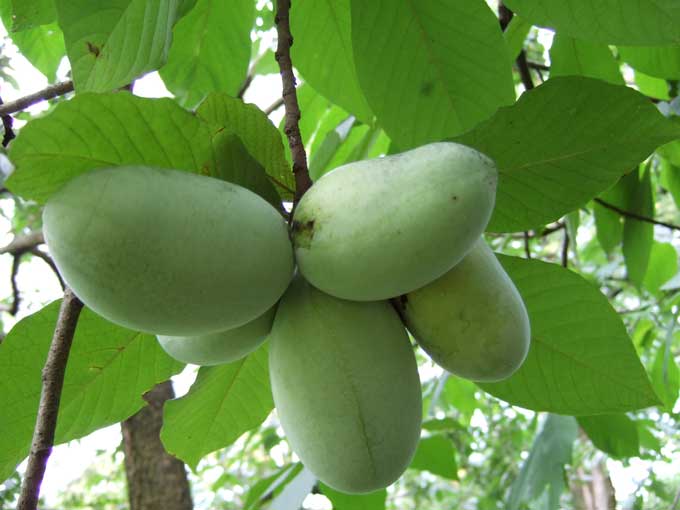Pawpaw Tree Biography
Papaya is a short-lived perennial growing to 30 ft (9.14 m) high. Its hollow, herbaceous stem is usually unbranched. The deeply lobed, palmate leaves are borne on long, hollow petioles emerging from the stem apex. Flowers occur in leaf axils. Older leaves die and fall as the tree grows.
Papaya flowers are fragrant and have five cream-white to yellow-orange petals 1 to 2 in (2.5 to 5.1 cm) long. The stigmatic surfaces are pale green, and the stamens are bright yellow.
Papaya fruits are smooth skinned. They vary widely in size and shape, depending on variety and type of plant. Hermaphrodite plants of commercial 'Solo' varieties in Hawaii usually produce fruits that are pear shaped and weigh approximately 12 to 30 oz (340 to 851 g). Female plants of 'Solo' varieties produce round fruits. Other papaya varieties produce variously shaped fruits, which may weigh up to 20 lb (9.1 kg). The fruits usually contain many seeds surrounded by a smooth yellow to orange-red flesh that is sweet in good varieties.
Flower type. Flower type is determined by the presence or absence of functional stamens (male parts) and stigma and ovary (female parts). Within varieties, flower type is usually identified by flower size and shape.
Female flowers are relatively large and rounded at the base. They have a stigma but lack stamens. They generally must receive pollen in order to set fruit. Pollen can be carried by wind or by insects.
Male flowers are thin and tubular. They have perfect structure (i.e., they contain both male and female organs), but the small, vestigial ovary is nonfunctional. Male flowers are usually borne on a long flower stalk (peduncle).
Hermaphrodite flowers are intermediate between female and male flowers in size and shape. They are less bulbous than female flowers, but not as thin as male flowers. They have perfect structure with functional stigma and stamens and usually are self-pollinating.
Plant type. Three types of plants are recognized based on flower type: female, hermaphrodite, and male.
Female plants always produce female flowers. If no male or hermaphrodite plants are nearby to provide pollen, female plants usually fail to set fruit. Unpollinated female plants occasionally set parthenocarpic fruits, lacking seeds.
Male plants are distinguished by their long flower stalks bearing many flowers. Usually they do not produce fruit, but on rare occasions there is female expression in the flowers, and they may set fruits .
Hermaphrodite plants may have male flowers, hermaphrodite flowers, or both, depending on environmental conditions and the time of year. Hot, dry weather may cause suppression of the ovary and the production of female-sterile (i.e., male) flowers. This accounts for occasional seasonal failure of hermaphrodite plants to set fruit. Male flowers on hermaphrodite plants are borne on short peduncles.
Papaya is a short-lived perennial growing to 30 ft (9.14 m) high. Its hollow, herbaceous stem is usually unbranched. The deeply lobed, palmate leaves are borne on long, hollow petioles emerging from the stem apex. Flowers occur in leaf axils. Older leaves die and fall as the tree grows.
Papaya flowers are fragrant and have five cream-white to yellow-orange petals 1 to 2 in (2.5 to 5.1 cm) long. The stigmatic surfaces are pale green, and the stamens are bright yellow.
Papaya fruits are smooth skinned. They vary widely in size and shape, depending on variety and type of plant. Hermaphrodite plants of commercial 'Solo' varieties in Hawaii usually produce fruits that are pear shaped and weigh approximately 12 to 30 oz (340 to 851 g). Female plants of 'Solo' varieties produce round fruits. Other papaya varieties produce variously shaped fruits, which may weigh up to 20 lb (9.1 kg). The fruits usually contain many seeds surrounded by a smooth yellow to orange-red flesh that is sweet in good varieties.
Flower type. Flower type is determined by the presence or absence of functional stamens (male parts) and stigma and ovary (female parts). Within varieties, flower type is usually identified by flower size and shape.
Female flowers are relatively large and rounded at the base. They have a stigma but lack stamens. They generally must receive pollen in order to set fruit. Pollen can be carried by wind or by insects.
Male flowers are thin and tubular. They have perfect structure (i.e., they contain both male and female organs), but the small, vestigial ovary is nonfunctional. Male flowers are usually borne on a long flower stalk (peduncle).
Hermaphrodite flowers are intermediate between female and male flowers in size and shape. They are less bulbous than female flowers, but not as thin as male flowers. They have perfect structure with functional stigma and stamens and usually are self-pollinating.
Plant type. Three types of plants are recognized based on flower type: female, hermaphrodite, and male.
Female plants always produce female flowers. If no male or hermaphrodite plants are nearby to provide pollen, female plants usually fail to set fruit. Unpollinated female plants occasionally set parthenocarpic fruits, lacking seeds.
Male plants are distinguished by their long flower stalks bearing many flowers. Usually they do not produce fruit, but on rare occasions there is female expression in the flowers, and they may set fruits .
Hermaphrodite plants may have male flowers, hermaphrodite flowers, or both, depending on environmental conditions and the time of year. Hot, dry weather may cause suppression of the ovary and the production of female-sterile (i.e., male) flowers. This accounts for occasional seasonal failure of hermaphrodite plants to set fruit. Male flowers on hermaphrodite plants are borne on short peduncles.
Pawpaw Tree
Pawpaw Tree
Pawpaw Tree
Pawpaw Tree
Pawpaw Tree
Pawpaw Tree
Pawpaw Tree
Pawpaw Tree
Paw Paw Trees
How To Care For A Papaya Plant








No comments:
Post a Comment